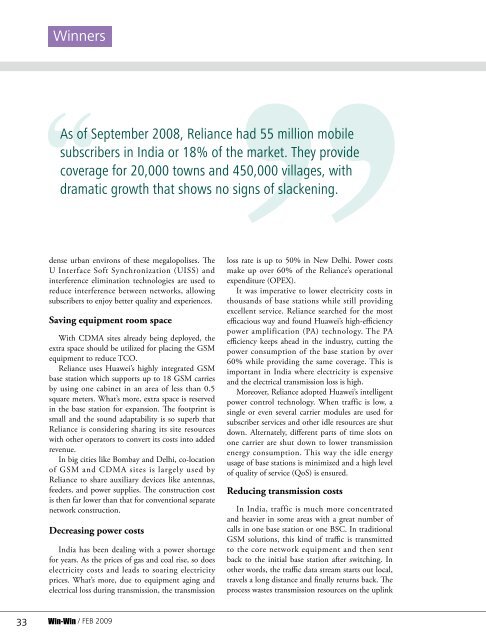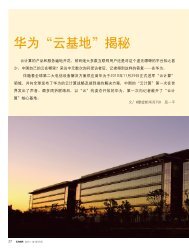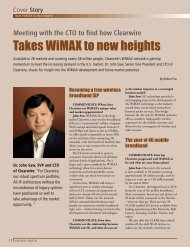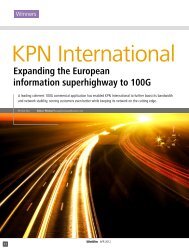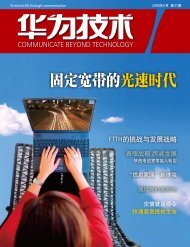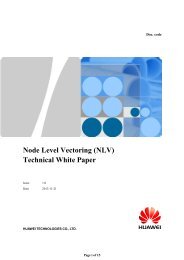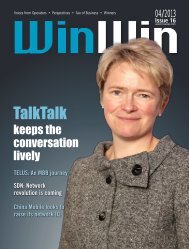EMOBILE: the mobile broadband revolutionist - Huawei
EMOBILE: the mobile broadband revolutionist - Huawei
EMOBILE: the mobile broadband revolutionist - Huawei
Create successful ePaper yourself
Turn your PDF publications into a flip-book with our unique Google optimized e-Paper software.
Winners<br />
As of September 2008, Reliance had 55 million <strong>mobile</strong><br />
subscribers in India or 18% of <strong>the</strong> market. They provide<br />
coverage for 20,000 towns and 450,000 villages, with<br />
dramatic growth that shows no signs of slackening.<br />
dense urban environs of <strong>the</strong>se megalopolises. The<br />
U Interface Soft Synchronization (UISS) and<br />
interference elimination technologies are used to<br />
reduce interference between networks, allowing<br />
subscribers to enjoy better quality and experiences.<br />
Saving equipment room space<br />
With CDMA sites already being deployed, <strong>the</strong><br />
extra space should be utilized for placing <strong>the</strong> GSM<br />
equipment to reduce TCO.<br />
Reliance uses <strong>Huawei</strong>’s highly integrated GSM<br />
base station which supports up to 18 GSM carries<br />
by using one cabinet in an area of less than 0.5<br />
square meters. What’s more, extra space is reserved<br />
in <strong>the</strong> base station for expansion. The footprint is<br />
small and <strong>the</strong> sound adaptability is so superb that<br />
Reliance is considering sharing its site resources<br />
with o<strong>the</strong>r operators to convert its costs into added<br />
revenue.<br />
In big cities like Bombay and Delhi, co-location<br />
of GSM and CDMA sites is largely used by<br />
Reliance to share auxiliary devices like antennas,<br />
feeders, and power supplies. The construction cost<br />
is <strong>the</strong>n far lower than that for conventional separate<br />
network construction.<br />
Decreasing power costs<br />
India has been dealing with a power shortage<br />
for years. As <strong>the</strong> prices of gas and coal rise, so does<br />
electricity costs and leads to soaring electricity<br />
prices. What’s more, due to equipment aging and<br />
electrical loss during transmission, <strong>the</strong> transmission<br />
loss rate is up to 50% in New Delhi. Power costs<br />
make up over 60% of <strong>the</strong> Reliance’s operational<br />
expenditure (OPEX).<br />
It was imperative to lower electricity costs in<br />
thousands of base stations while still providing<br />
excellent service. Reliance searched for <strong>the</strong> most<br />
efficacious way and found <strong>Huawei</strong>’s high-efficiency<br />
power amplification (PA) technology. The PA<br />
efficiency keeps ahead in <strong>the</strong> industry, cutting <strong>the</strong><br />
power consumption of <strong>the</strong> base station by over<br />
60% while providing <strong>the</strong> same coverage. This is<br />
important in India where electricity is expensive<br />
and <strong>the</strong> electrical transmission loss is high.<br />
Moreover, Reliance adopted <strong>Huawei</strong>’s intelligent<br />
power control technology. When traffic is low, a<br />
single or even several carrier modules are used for<br />
subscriber services and o<strong>the</strong>r idle resources are shut<br />
down. Alternately, different parts of time slots on<br />
one carrier are shut down to lower transmission<br />
energy consumption. This way <strong>the</strong> idle energy<br />
usage of base stations is minimized and a high level<br />
of quality of service (QoS) is ensured.<br />
Reducing transmission costs<br />
In India, traffic is much more concentrated<br />
and heavier in some areas with a great number of<br />
calls in one base station or one BSC. In traditional<br />
GSM solutions, this kind of traffic is transmitted<br />
to <strong>the</strong> core network equipment and <strong>the</strong>n sent<br />
back to <strong>the</strong> initial base station after switching. In<br />
o<strong>the</strong>r words, <strong>the</strong> traffic data stream starts out local,<br />
travels a long distance and finally returns back. The<br />
process wastes transmission resources on <strong>the</strong> uplink<br />
33<br />
Win-Win / FEB 2009


